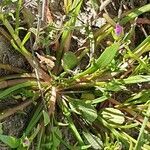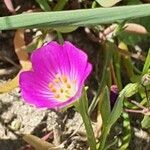A succulent annual herb. It keeps growing from year to year. It usually lies along the ground. It grows 30 cm high and 50 cm wide. The stems can be 25 cm long. They are low and branching. The leaves are greyish-green and hairy. The flowers are purple fading to white. They are at the ends of branches. The seeds are black.




